Unfinity Mechanics
Welcome to Myra the Magnificent's Intergalactic Astrotorium of Fun! It's the galaxy's most awesome entertainment complex. For just a few credits, or whatever currency your planet uses, the finest food, games, rides, safety documentation, pets, rest areas, museums, variety shows, trash receptacles, dance routines, wildlife, and more is yours for the asking. That's right, Magic is escaping to the one place that hasn't been corrupted by a lack of capitalism
Unfinity has a few major mechanics which we'll review here, but there are also a lot of individual cards that embrace all the wackiness Un- sets bring to (and sometimes under) the table. Before we dive into the mechanics, there's one change to the frame design that bears mentioning.
To preorder Unfinity, check with your local game store, online at Amazon, and elsewhere Magic is sold.
Goodbye, Silver Borders
Starting with this set, we're retiring silver borders as the way to communicate that a card doesn't quite follow the normal rules and isn't intended for competitive play. In its place, we've created the acorn symbol.
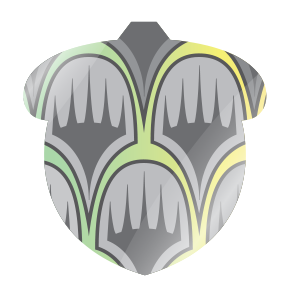
On cards that get a security stamp (usually rares and mythic rares), the acorn symbol will be that security stamp. On cards that don't get a security stamp (usually commons and uncommons), the acorn will be a printed stamp where the security stamp would have been. Acorn cards aren't legal in Constructed formats unless specifically allowed. They often do things that aren't covered by the Comprehensive Rules.
But not all the cards in Unfinity are acorn cards. The other portion of the set includes Eternal-legal cards. These either have no security stamp or the traditional oval security stamp. They look just like tournament-legal cards because they are tournament-legal cards. They're legal in Commander and other Eternal formats (Legacy and Vintage). They are or will be supported by the Comprehensive Rules.
Any card that previously referred to a "silver-bordered game" now refers to an "Un- game." They mean the same thing, though. It's any game in which at least one player is playing acorn cards or older silver-bordered cards from Un- sets or things like holiday promos. Cards that specifically referred to borders (like Border Guardian) won't be changing. They look at the actual printing of the card in question, so they'll still see the acorn cards as having black borders, and they'll see older cards as having silver borders.
We're excited about this new presentation for cardboard silliness, and we hope it sticks. Oh, speaking of
Stickers
Each Unfinity booster includes a sticker sheet. Stickers are a new way to bedazzle your cards and get some cool bonuses in the process.
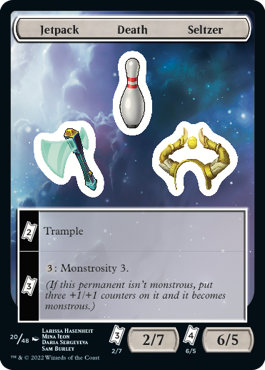
There are four kinds of stickers on each sheet:
- Three name stickers. They can become the first word of a card's name, the last word of that name, or squeeze in between any two words in that name. For example, the sticker "Dark" + Runeclaw Bear = Dark Runeclaw Bear, Runeclaw Dark Bear, or Runeclaw Bear Dark.
- Three art stickers. Add fun things to the art of your cards! Art stickers always add to a card's art. They never erase existing art. For example, if a creature's art shows it wearing a hat, and you cover the hat with a frog, it's still wearing the hat.
- Two ability stickers. Your cards do cool things. Make them do more cool things! Ability stickers are always additive—they never erase any text, even if they happen to cover it.
- Two power and toughness stickers. Maybe your creature isn't the right size? Try on something bigger. Power and toughness stickers are the only ones that overwrite text. Creatures can have only power and toughness, after all.
Some effects instruct you to put any sticker on something. Others will specify a particular kind of sticker. Stickers work on tokens just as well as they work on nontoken permanents. Each effect will let you know what it can apply to.
Ability stickers, and power and toughness stickers, have a ticket icon next to them. This is the ticket cost, and you must pay that cost to place that sticker. What are tickets? Tickets are a new kind of counter that players get. Many effects that let you place stickers also give you some tickets. Name and art stickers are always free, assuming there's an effect letting you place them.
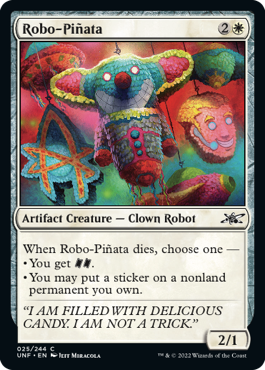
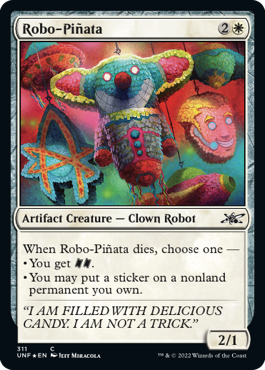
A sticker's physical location doesn't matter. You don't need to worry too much about lining it up correctly. Stickers will just work. If there's any ambiguity (see name stickers above), announce to all players what exactly the sticker is doing as you place it. There are a few acorn cards that are exceptions, but they'll call out how they care about where the sticker is.
One important thing: You can never sticker anything you don't own. If an effect instructs you to do this, ignore it. Most abilities that put stickers on things say "a nonland permanent you own," but a few things sticker themselves as or when they enter the battlefield. If they enter under the control of someone who isn't their owner, that player won't get to sticker them.
In each game, you have access to three sticker sheets, as follows:
- In Constructed games, you can bring at least ten unique sticker sheets. No repeats, and you can't bring more than 48, as that's all we made. Before each game, choose three at random from the sheets you brought. Those are your three for that game.
- In Sealed Deck, before each game, choose up to three from among the sticker sheets you opened.
- In Booster Draft, sticker sheets aren't drafted. After you open an Unfinity booster, remove the sticker sheet before drafting any cards. Before each game, choose up to three from among the sticker sheets you opened.
Attractions
Attractions represent all the rides, games, and shops you might visit while on the midway. Attractions aren't played in your main decks, and they don't have normal Magic backs. Rather, they're played in their own deck called the Attraction deck.
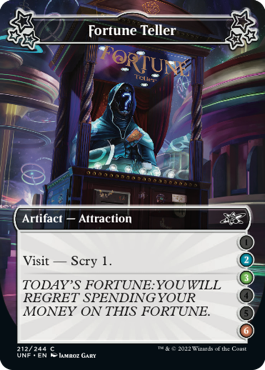
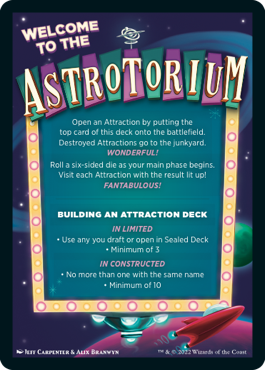
Attractions are artifacts, but you'll notice they don't have a mana cost. They aren't cast, and in fact, they never even go to your hand. To get them from your Attraction deck to the battlefield, you'll need to open them, using cards like "Lifetime" Pass Holder.
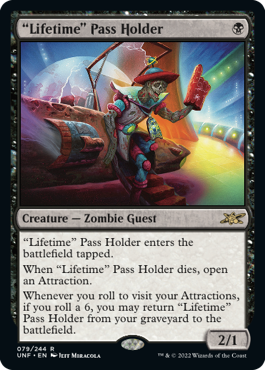
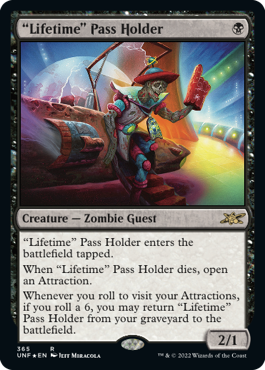
When told to open an Attraction, put the top card of your Attraction deck onto the battlefield face up under your control. Each Attraction has lights numbered 1–6 in the lower right corner. In fact, different versions of the same Attraction may have different lights lit up. The number 1 will never be lit up, and the number 6 will always be lit up.

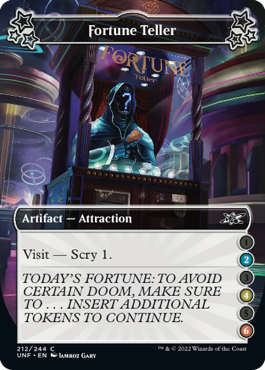

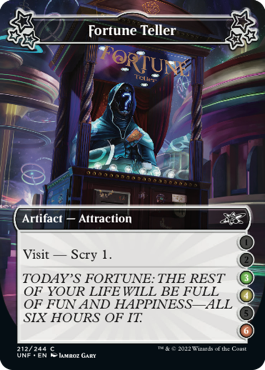

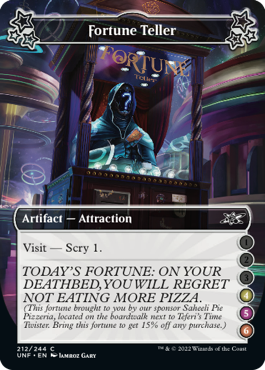
At the beginning of your first main phase on each of your turns, you roll to visit your Attractions by rolling a six-sided die. If the result is lit up on an Attraction you control, you visit that Attraction, causing that Attraction's visit ability to trigger. You visit Attractions only for this special die roll or if a card specifically tells you to roll to visit your Attractions. Other die rolls caused by spells and abilities won't cause visit abilities to trigger.
If an Attraction would leave the battlefield and go to any zone other than exile, it instead goes to the junkyard, the Attraction deck's version of the scrapyard, which is the Contraption deck's version of the graveyard. Things that affect the graveyard do not affect the junkyard. You can exile Attractions just fine.
Some Attractions offer minigames and prizes!

The prize is a reward for winning the minigame offered by the visit ability. Although these Attractions close down after you claim their prizes, you do get to open another to replace it.
In Limited formats (Sealed Deck and Booster Draft), your Attraction deck must contain at least three Attraction cards and may contain duplicates. In Booster Draft specifically, Attractions are drafted like other cards in the booster. If you don't draft at least three Attraction cards, you won't be able to use an Attraction deck. In Constructed games, your Attraction deck must contain at least ten Attraction cards and it must be "Singleton," that is, no more than one card with any specific name (even if they have different text or lights lit up).
Hats
What's better than having the time of your life at the Astrotorium? Having the time of your life at the Astrotorium in a stylish hat, of course! Several Unfinity cards care deeply about hats, as do we all.

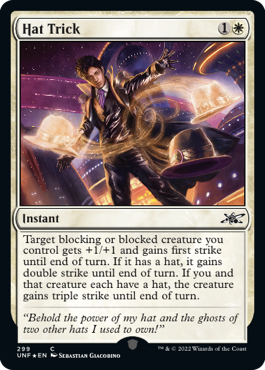
"What is a hat?" you might be wondering. Unlikely, but just in case: A hat is a garment worn on the head that's not part of another garment. No hoodies or face masks, for example. Hats are intentional. You can't just put any old thing on your head and call it a hat. However, we do count wigs and headbands.
Most cards refer to "having a hat." For a creature, that means a hat shows up in the art. The creature doesn't have to be wearing it, though it does need to be in possession of it. For a player, same rules apply. You don't have to wear the hat, but it must be with you. If a card specifies "wearing a hat," it means just that. You can't physically mess with another player's hat (or other possessions or self or anything). It's very unsporting and will get you ejected from the Astrotorium.
Wordplay
Here at Unfinity, we word good, and so can you! Several cards care about specific words or letters appearing on cards, the number of words that appear in various places, or other wordplay. For the most part, these effects are limited to Un- games, however, effects that look specifically at stickers (which appear only in English) and may appear on Eternal cards:
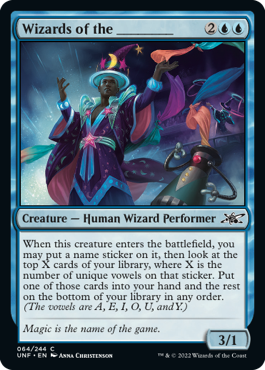
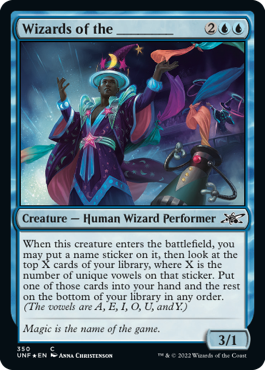
In Un- games, anything that cares about text or other features of a card uses the actual card you're playing with to determine that information. So, two copies of the same card could have different names if they're in different languages. In traditional games, everything uses Oracle text regardless of what version you're playing with.
Dice
We're no strangers to dice. You know the rules, and so do I. Unfinity has a full commitment to six-sided dice. You wouldn't get results from any other die (in this set, anyway).

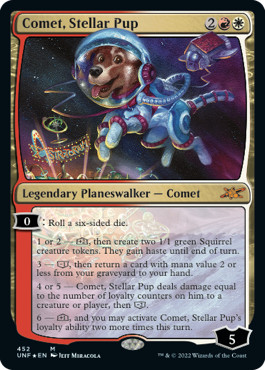
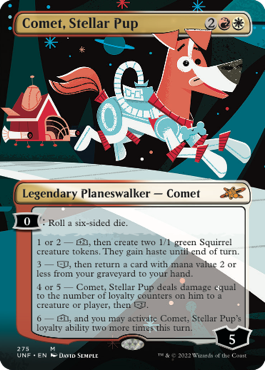
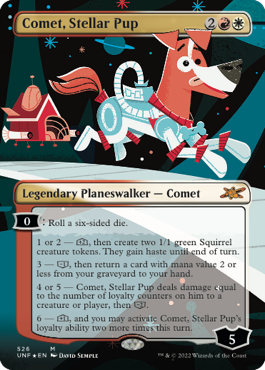
You've seen how rolling a six-sided die is used to visit Attractions, but there's so much more. Some spells and abilities, like Comet's loyalty ability, use the results of die rolls to determine their effects. You might also roll dice to determine a creature's power and toughness. It just gets stranger from there. One thing's for sure, though—Comet's a real never-gonna-leave-you pup. He's never gonna let you down.
People Outside the Game
Normally, we're not big fans of people not playing Magic, but they can be very useful for Unfinity cards that require someone outside the game to determine what happens.
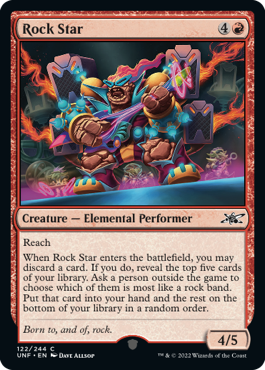
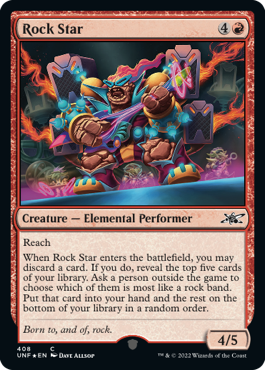
Anyone not currently playing in your game is outside your game, even someone who was in your game but lost. Those people might have agendas, though. It doesn't have to be a Magic player or someone who has an idea of what's going on. Each card will explain what you can explain. Importantly, no one should try to unduly influence the outside person's choices. If there's no one around, calling or texting someone for help is usually fine.

